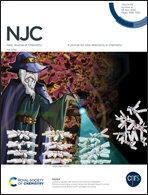Electrochemical water oxidation catalyzed by a mononuclear cobalt complex of a pentadentate ligand: the critical effect of the borate anion†
Abstract
Electrochemical water oxidation catalyzed by a cobalt complex, [Co(N3Py2)(H2O)] (ClO4)2 (1) (N3Py2 = 2,5,8-trimethyl-1,9-bis(2-pyridyl)-2,5,8-triazanonane), is reported. The release of dioxygen (O2) occurs with a moderate onset overpotential of 540 mV and turnover frequency (kcat) of 0.79 s−1. Collective experimental results confirm that 1 homogeneously catalyzes water oxidation without undergoing decomposition into cobalt oxides or cobalt hydroxides. Detailed electrochemical investigation clarified the mechanism of water oxidation, indicating that the implementation of a proton-coupled electron transfer (PCET) process and the formation of an O–O bond in the catalytic cycle are assisted by the ion of the buffer solution. Compared to hydrogen phosphate, borate, which is more receptive to protons, leads to a more remarkable catalytic activity. This work suggests that the buffer solution may have a critical effect on the catalytic performance of metal complexes. The disclosed information is expected to inspire new ideas for the development of efficient homogeneous complex catalysts for water oxidation.



 Please wait while we load your content...
Please wait while we load your content...